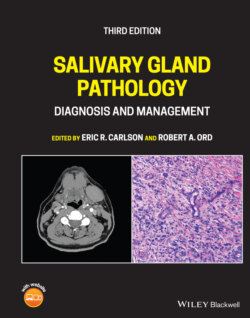Читать книгу Salivary Gland Pathology - Группа авторов - Страница 117
Bacterial Salivary Gland Infections ACUTE BACTERIAL PAROTITIS
ОглавлениеWorld history indicates that acute bacterial parotitis (ABP) played a significant role in its chronicles, particularly in the United States. We are told that the first case of acute bacterial parotitis occurred in Paris in 1829 in a 71‐year‐old man where the parotitis progressed to gangrene (McQuone 1999; Miloro and Goldberg 2002). As mumps plays a role in the differential diagnosis of infectious parotitis, Brodie's distinction between acute bacterial parotitis and viral mumps in 1834 represents a major inroad into the understanding of this pathologic process (Brodie 1834; Goldberg and Bevilacqua 1995). Prior to the modern surgical era, ABP was not uncommonly observed, and indeed represented a dreaded complication of major surgery, with a mortality rate as high as 50% (Goldberg and Bevilacqua 1995). Ineffective postoperative intravascular volume repletion with resultant diminished salivary flow and dry mouth were the norm rather than the exception. President Garfield sustained a gunshot wound to the abdomen in July 1881 and developed chronic peritonitis and ultimately died several weeks later. The terminal event was described as suppurative parotitis that led to sepsis (Goldberg and Bevilacqua 1995; Carlson 2009).
It has been pointed out that upper and lower aerodigestive tract surgeries require patients to be without oral nutritional intake or with limited oral intake postoperatively (McQuone 1999). The reduction of salivary stimulation predisposes these patients to acute bacterial parotitis, with an estimated incidence of 1 in 1000 postoperative patients (Andrews et al. 1989). Other statistics showed 3.68 cases per 10,000 operations in the preantibiotic era compared with 0.173 in 10,000 operations in the antibiotic era (Robinson 1955). The prophylactic use of antibiotics has probably contributed to the reduction of cases of acute bacterial parotitis. In addition, intraoperative and postoperative intravenous hydration became well accepted in the 1930s, particularly during World War II, therefore also contributing to the reduction in the incidence of ABP. In 1958, Petersdorf reported seven cases of staphylococcal parotitis and the 1960s ushered in several reports of ABP as a disease making a comeback (Petersdorf et al. 1958; Goldberg and Bevilacqua 1995). Of Petersdorf's seven cases, five of the patients had undergone surgery, and two of the patients died in the hospital. Oral and maxillofacial surgeons began to report cases of ABP in the literature in the 1960s (Goldberg and Harrigan 1965; Guralnick et al. 1968). These cases were most likely due to the emergence of penicillin‐resistant bacteria (Lewis 1995), like contemporary reports of methicillin‐resistant Staphylococcus aureus parotitis (Nicolasora 2009).
The parotid gland's relative propensity for infection results from physiologic and anatomic factors. Parotid saliva differs from that of the submandibular and sublingual glands. Parotid saliva is predominantly serous compared to the mucinous saliva from the submandibular and sublingual glands. Mucoid saliva contains lysosomes and IgA antibodies, which protect against bacterial infection. Mucins also contain sialic acid, which agglutinates bacteria, thereby preventing its adherence to host tissues. Glycoproteins found in mucins bind epithelial cells, thereby inhibiting bacterial attachment to the epithelial cells of the salivary duct.
